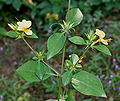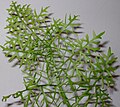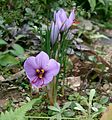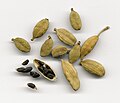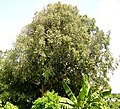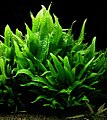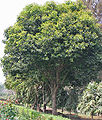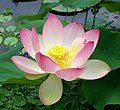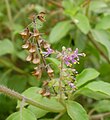Plants of commercial importance
* Click on the arrows besides the column headers to sort the table by that column * Clicking on the blue links will lead you to the respective pages
If some information is missing or you think is wrong, YOU CAN CHANGE IT YOURSELF!!! Click here to know how...
A total of 48 plants having commercial importance as YES
Images of commercially important plants
48 species in this category.
Acacia concinna (Soap pod)
Acacia nilotica (Arabic Gum, Black Piquant, Egyptian thorn, Prickly acacia)
Achillea millefolium (Common Yarrow, Gordaldo, Nosebleed plant, Old man's pepper, Devil's nettle, Sanguinary, Milfoil, Soldier's woundwort, Thousand-leaf, Thousand-seal.)
Adansonia digitata (Baobab)
Allium sativum (Cultivated Garlic)
Aloe vera (Aloe vera, Medicinal aloe, Burn plant)
Artocarpus heterophyllus (Jackfruit)
Azadirachta indica (Neem)
Azolla pinnata (Mosquito fern, Duckweed fern, Fairy moss, Water fern)
Barleria prionitis (Porcupine flower)
Boerhavia diffusa (Red hogweed, Tar Vine, Red Spiderling, Wineflower)
Boswellia serrata (Indian Olibanum)
Catharanthus roseus (Tiny Periwinkle, Vinca)
Cedrus deodara (Deodar Cedar)
Ceratopteris pteridoides (Floating antlerfern)
Ceratopteris thalictroides (Water sprite, Indian fern, Water fern, Oriental waterfern, Water hornfern)
Cinnamomum tamala (Indian Bay Leaf, Indian cassia, Indian cassia bark, Tamala cassia, Malabar Leaf)
Cocos nucifera (Coconut)
Coriandrum sativum (Coriander)
Crocus sativus (Saffron)
Curcuma longa (Common Turmeric)
Curcuma zedoaria (White turmeric, Zedoary)
Cyperus rotundus (Common Nut Sedge, Coco grass, Nutgrass, Purple nutsedge)
Daucus carota (Wild carrot, Bird's nest, Bishop's lace, Queen Anne's lace)
Elettaria cardamomum (Cardamom, Green cardamom)
Eucalyptus globulus (Tasmanian Blue Gum, Southern Blue Gum, Blue Gum)
Glycyrrhiza glabra (Cultivated Liquorice, Sweetwood)
Hygrophila auriculata (Hygrophila, Temple plant, Marsh Barbel)
Jasminum officinale (Common Jasmine, Poet's Jasmine, Spanish Jasmine)
Jasminum sambac (Jasmine)
Madhuca longifolia (Mahua)
Mangifera indica (Mango)
Mesua ferrea (Cobra saffron, Ceylon ironwood, Indian rose chestnut)
Microsorum pteropus (Java fern)
Mimusops elengi (Spanish cherry, Bullet wood)
Murraya exotica (Chinese box, Orange Jasmine)
Nelumbo nucifera (Water Lily, Lotus, Sacred Lotus, East Indian Lotus)
Nymphaea nouchali (Blue water lily, Red and blue water lily', Blue star water lily, Star lotus)
Ocimum tenuiflorum (Holy Basil, Indian Basil)
- Indiangooseberrypickle.jpg
Phyllanthus emblica (Indian Gooseberry, Amla)
Rauwolfia serpentina (Indian snakeroot, Serpentine wood)
Santalum album (Indian Sandalwood, White Sandalwood)
Sesamum indicum (Sesame)
Syzygium aromaticum (Clove)
Zingiber officinale (Garden ginger)
List of plants
| Species name | Common name | Name in Hindi | Introdescription | Commercial application | Plant commercial part | Commercial use description |
|---|---|---|---|---|---|---|
| Azolla pinnata | Mosquito fern, Duckweed fern, Fairy moss, Water fern | Animal consumption Agricultural use | Azolla has been used, for at least one thousand years, in rice paddies as a companion plant, because of its ability to both fix nitrogen, and block out light to prevent any competition from other plants, aside from the rice, which is planted when tall enough to poke out of the water through the azolla layer. When rice paddies are flooded in the spring, they can be inoculated with Azolla, which then quickly multiplies to cover the water, suppressing weeds. The rotting plant material releases nitrogen to the rice plants, providing up to nine tonnes of protein per hectare per year. The nitrogen fixing ability of Azolla is due to the cyanobacteria in the plant. It can replace 25-30 kg nitrogen per hectare as applied through ammonium sulfate. | |||
| Madhuca longifolia | Mahua | महुआ Mahua | Madhuca longifolia, commonly known as mahwa or mahua, is an Indian tropical tree found largely in the central and north Indian plains and forests. It is a fast growing tree that grows to approximately 20 meters in height, possesses evergreen or semi-evergreen foliage, and belongs to the family Sapotaceae. It is adapted to arid environments, being a prominent tree in tropical mixed deciduous forests in India in the states of Jharkhand, Uttar Pradesh, Bihar, Madhya Pradesh, Kerala, Gujarat and Orissa (Source: Wikipedia) | Human consumption Medicinal use Religious use Wood | Root Stem Bark Leaves Flower Seeds | About 30-40 percent of the tribal economy in north India such as in Bihar, Madhya Pradesh and Orissa is dependent on the mahua seeds and flowers. The tree has a potential of enhancing rural income. (Hindu) Madhuca indica (syn. Madhuca latifolia, Bassia latifolia,) is a deciduous tree found in India. It bears edible flowers and fruit. The tree has a spreading root system so can be used to prevent soil erosion. The timber is hard and is used in construction. Bark of the tree is known to have medicinal properties. Seed is rich in oil and has been used in soap and candle making. Seed cake is used as an organic fertilizer. M. indica is being explored as a potential source of biofuel. (NCBI Taxonomy) |
| Santalum album | Indian Sandalwood, White Sandalwood | चन्दन Chandan | Sandalwood is an economically important plant and has been cultivated for several centuries for the fragrance of its oil. Due to extensive and sometimes, illegal cutting of native Sandalwood trees, this species has become vulnerable to extinction. S. album is native to South/South-East Asia, possibly Indonesia. Another species Santalum spicatum is native to Australia. | Human consumption Medicinal use Cosmetic use Religious use Wood | Root Stem Bark Seeds | Almost all of the sandalwood oil in the world is produced from the S.album. The highest content is in the roots followed by the heartwood. Sandalwood oil is used in high-quality perfumes and cosmetics and Ayurvedic creams. India is the largest producer of Sandalwood. Production is based almost entirely on exploitation of wild trees.
Sandalwood is also popular as carving wood and for making souvenirs and toys. The wood is used in religious practices in Hinduism. The cotyledons and kernel of sandal seeds contain a fixed oil which has drying properties. Oil-free sandal seed meal is rich in protein and could be utilized as an animal feed if available in sufficient quantities. The oil may also be used as a food additive (GRIN) |
| Nelumbo nucifera | Water Lily, Lotus, Sacred Lotus, East Indian Lotus | कमल Kamal | The Indian Lotus, also known as the Sacred Lotus, is a culturally significant plant in many Asian cultures in general and Indian culture in particular. It is a plant native to the Indian subcontinent, but now is found as an ornamental plant worldwide. The Lotus is considered a symbol of devotion and purity. It is the seat of Goddess Lakshmi, Goddess Saraswati, Lord Vishnu and Lord Brahma. The flowers of Lotus have several medicinal properties as per Ayurveda. Lotus is also the national flower of India. | Human consumption Ornamental use Religious use | Entire plant Root Rhizomes Stem Leaves Flower Fruit Seeds | Almost all parts of the plant have medicinal and culinary uses as previously described. The plant is also a prized ornamental plant, especially in artificial ponds. |
| Hygrophila auriculata | Hygrophila, Temple plant, Marsh Barbel | तालीम ख़ाना Talim Khana | Hygrophila auriculata is belongs to the genus Hygrophila whose identity as a separate genus is still debated. H. auriculata is an aquatic, perennial herb which has medicinal properties in treating liver ailments according to Ayurveda. | Medicinal use Ornamental use | Entire plant Root Leaves Seeds | As described previously, the plant parts can be used to treat liver ailments. In addition, the plant also bears beautiful blue-colored flowers and hence can be used in aquariums and artificial ponds as an ornamental plant. |
| Achillea millefolium | Common Yarrow, Gordaldo, Nosebleed plant, Old man's pepper, Devil's nettle, Sanguinary, Milfoil, Soldier's woundwort, Thousand-leaf, Thousand-seal. | Gandrain, Puthkanda, भूतकॆशी Bhut Kesi | Achillea millefolium or yarrow is a flowering plant in the family Asteraceae, native to the Northern Hemisphere. In antiquity, yarrow was known as herbal militaris, for its use in staunching the flow of blood from wounds. Yarrows can be planted to combat soil erosion due to the plant's resistance to drought. They are used for human consumption and medicinal uses in many cultures around the world. (Source:Wikipedia) | Human consumption Animal consumption Medicinal use Other use | Can be used to prevent soil erosion | |
| Cocos nucifera | Coconut | नारियल Naariyal | Human consumption Animal consumption Agricultural use Cosmetic use Ornamental use Religious use Industrial use Wood | Root Stem Bark Leaves Fruit | Coconut leaves are used for making brooms. Bark and coir (fruit hair) used for making brooms, ropes, mattresses, brushes and even as potting compost. Fruit is used in several food preparations, most notably chutneys and coconut sweets.Coconut milk is rich in fatty acids (17% fat content) and used for making hair oils and edible oils.
The dried calyx of the coconut is used as fuel in wood fired stoves. The fresh husk of a brown coconut is also used as a dish sponge or as a body sponge.Coconut roots are used as a dye and a mouthwash.Coconut trunks are used for building small bridges; they are preferred for their straightness, strength and salt resistance. In Kerala (India), coconut trunks are used for house construction.The husk and shells can be used for fuel and are a source of charcoal. | |
| Ceratopteris pteridoides | Floating antlerfern | Ceratopteris species are aquatic pteridophytic ferns, generally found in tropical regions. They require a warm climate and lots of water. Two species - C. pteridoides and C. thalictroides are found in India. There is confusion among botanists on whether Ceratopteris cornuta and C. pteridoides are separate species. | Ornamental use | Other | Entire plant is used as an ornamental plant in aquariums. | |
| Jasminum sambac | Jasmine | बेला Bela, मोतिया Motiya, मोगरा Mogra | Jasminum sambac is a species of jasmine native to southwestern and southern Asia, in the Philippines, India, Myanmar and Sri Lanka. It is grown mainly as an ornamental plant due to its fragrant and beautiful flowers. | Human consumption Ornamental use | Flavouring agent: to flavour tea in China, Making Perfumes,for making garlands and bouquets and for religious offerings. | |
| Murraya exotica | Chinese box, Orange Jasmine | Kamini कामिनी | This species is used sometimes as an ornamental plant in India and has a medicinal use. Murraya exotica is related to Murraya koenigii or Curry plant, which is used as a spice in Indian foods. M. exotica leaves, on the other hand, have a citrus flavor. | Medicinal use Ornamental use Wood Other use | Entire plant Stem Leaves | It is a popular hedge plant in tropics. It can be pruned into various shapes of animals and can be used as a garden ornamental plant. It can also be cultivated as a bonsai. Can also be grown indoors.
The wood of the plant is soft and can be used for making small, fine-tuned items. Orange Jasmine contributes to biodiversity, protects the soil, furnishes food and cover for wildlife. It also has medicinal use as previously described. |
| … further results | ||||||
Click on further results on bottom right corner of the above table to get an exhaustive list
The code used to generate the above table
{{#ask: [[Category:Plants]] [[Plant commercial::Yes]]
| ?Common name
| ?Common hindi name=Name in Hindi
| ?Introdescription
| ?Commercial application
| ?Plant commercial part
| ?Commercial use description
| limit=10
| sort=Commercial use description
| mainlabel=Species name
}}









